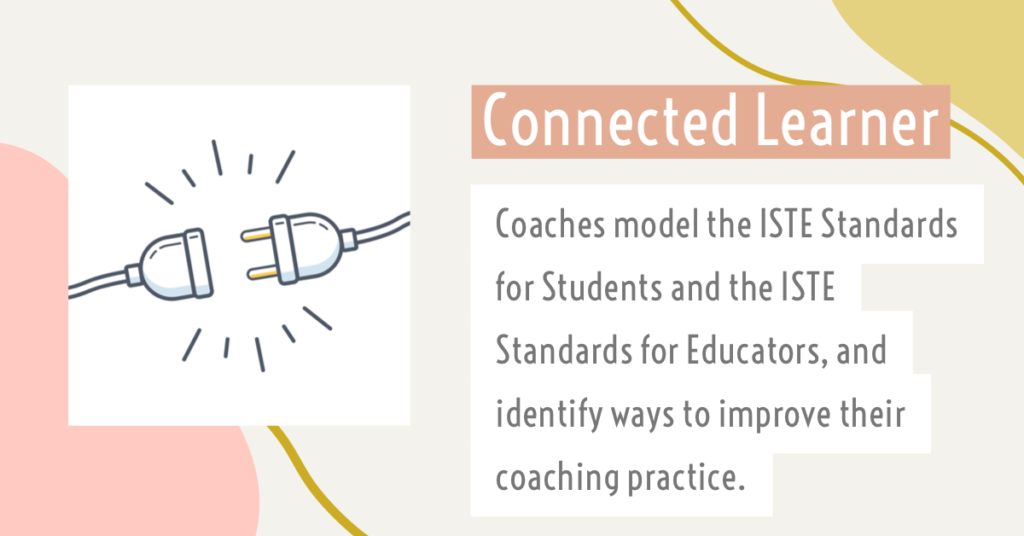2a

Coaches are dedicated to continually refining and improving their craft. Substandard a states that coaches “Pursue learning that deepens their expertise in the ISTE Standards” This is a standard I can get behind! I love learning new things and trying emerging strategies in my classroom. Here are some examples of how I have pursued professional learning for myself in order to increase my knowledge and expertise of the ISTE Standards:
- The DEL Program: In 2019 I enrolled in Seattle Pacific University’s Master’s in Digital Education Leadership (DEL) program. During our program, we unpacked the Student, Teacher, and Coaching Standards. Now I feel equipped to support teachers in purposefully incorporating the ISTE Standards into their instruction. One example of me helping teachers become proficient with the ISTE standards was when I assisted a 3rd-grade teacher with the Global Collaborator standard. I showed her various ways to network and connect with other teachers through social media. After connecting with teachers around the nation, we used FlipGrid to allow students to dialogue about culture.
- STEM: Another way I have continued my learning on the ISTE Standards is by taking an elective class on how to infuse STEM into the elementary classroom. ISTE highlights in Student Standard 4 the importance of encouraging students to be innovative designers. Laura McLaughlin (2017) commented that by encouraging students to think through problems and come up with creative solutions, we are helping foster adults who will be open-minded, flexible, self-directed problem solvers who can make a difference in their own communities and the world. STEM challenges are a great way to allow your students to practice being innovative designers. In my elective, I learned about three ways to incorporate STEM into your instruction: thematically, using a cross-cutting concept approach, and aligning with standards. While participating in the class I partnered with teachers at my school to design various STEM challenges. For a 2nd grade STEM activity, we asked students to design their own house for the 3 Little Pigs and use a green screen to publish their narrative writing. For a 5th grade class, we created a STEM challenge where students used coding and Makey Makey kits to construct an interactive food web. Read more about infusing STEM into your classroom at Using STEM to Encourage Innovative Designers.
- Coding and Computational Thinking: I have also attended several trainings and workshops on coding and computational thinking. This furthered my understanding of Student Standard 5: Computational Thinker. Computational thinking is all about taking a big problem, breaking it down into smaller pieces, working on those pieces individually, and then bringing it back together in order to solve the problem. If computational thinking is new to you, discover more in my blog post: Computational Thinking and Play. One training I attended was through Code.org. I was very impressed and saw the benefit of having our students start to practice coding K-8. I went back to my school and advocated that we adopt their free curriculum school-wide, which was approved. We ended up sending our whole staff to the training and I continued to support teachers as they started to incorporate more coding lessons into their weekly instruction. I also attended a training done by the ESD 112 on Computer Science. During this three-day workshop, I learned more about coding and various types of technology we can use with our students such as Scratch, Ozobots, and Makey Makey. I have used my learning in this standard to educate, support, and co-teach with teachers at my school.
- Maker Spaces: One way I practiced Educator Standard 1: Learner was by researching Maker Spaces. Substandard c says educators “stay current with research that supports improved student learning outcomes, including findings from the learning sciences” (ISTE). In my blog post, “Should I Join the Maker Movement?”, I share about this educational fad and how it improves student learning. Maker spaces give students the hands-on opportunity to work through an iterative design process, practice having a growth mindset, use executive function skills, and express themselves creatively. Mcquinn (2018) argues that maker spaces align powerfully with what neuroscience tells us about how the brain works.
To read more about my work with this standard, you can use the drop-down menu above or the buttons below to navigate to a specific performance indicator.
Works Cited
ISTE Standards for Students. (n.d.). Retrieved from https://www.iste.org/standards/for-students
ISTE Standards for Educators. (n.d.) Retrieved from https://www.iste.org/standards/for-educators
ISTE Standards for Coaches (n.d.). Retrieved from: https://www.iste.org/standards/for-coaches
McLaughlin, Laura (2017, September 13). 5 ways to help students become innovative designers. ISTE. https://www.iste.org/explore/ISTE-Standards-in-Action/5-ways-to-help-students-become-innovative-designers
Reagan, Miranda Talley (2016). STEM-Infusing the Elementary Classroom. SAGE Publications Ltd.
